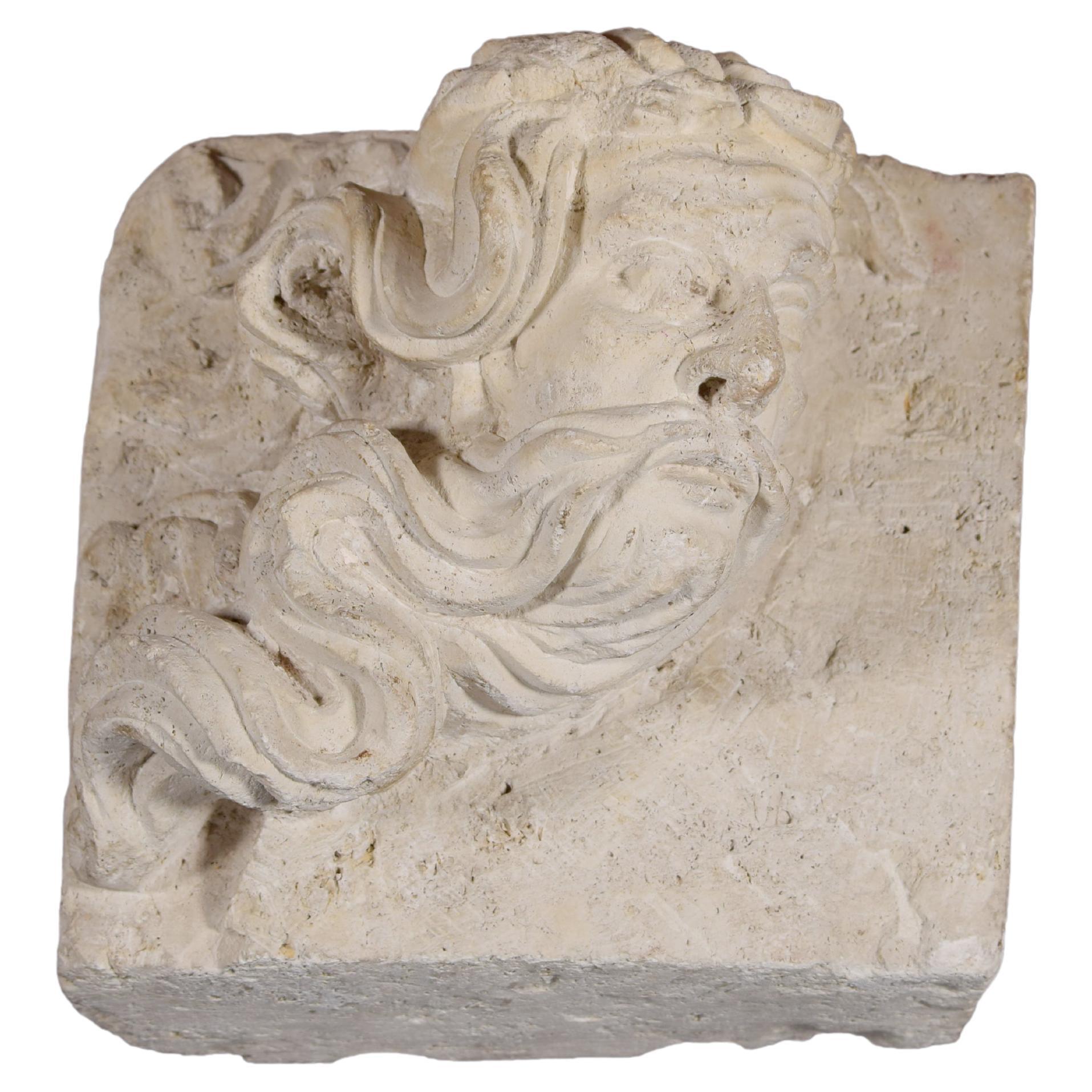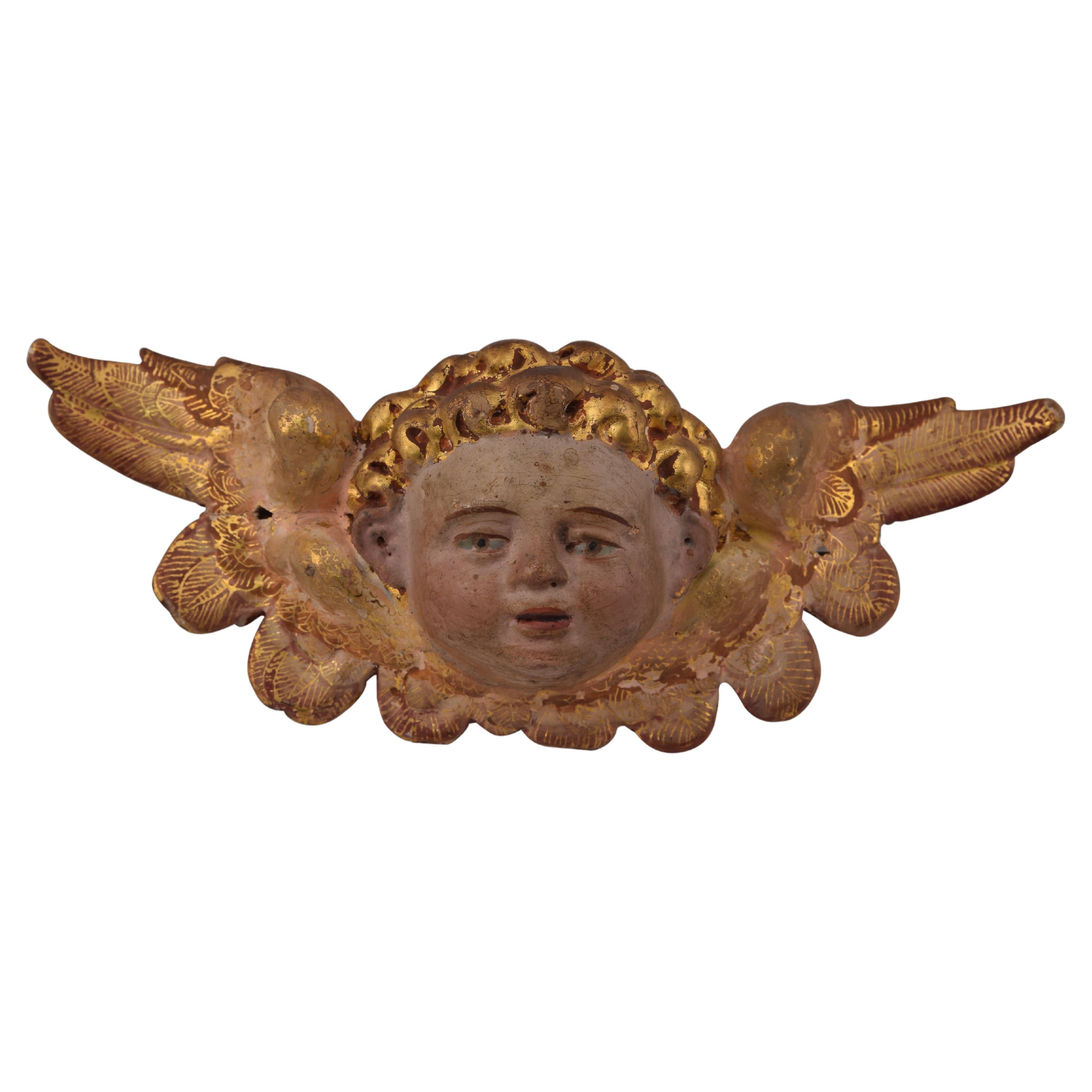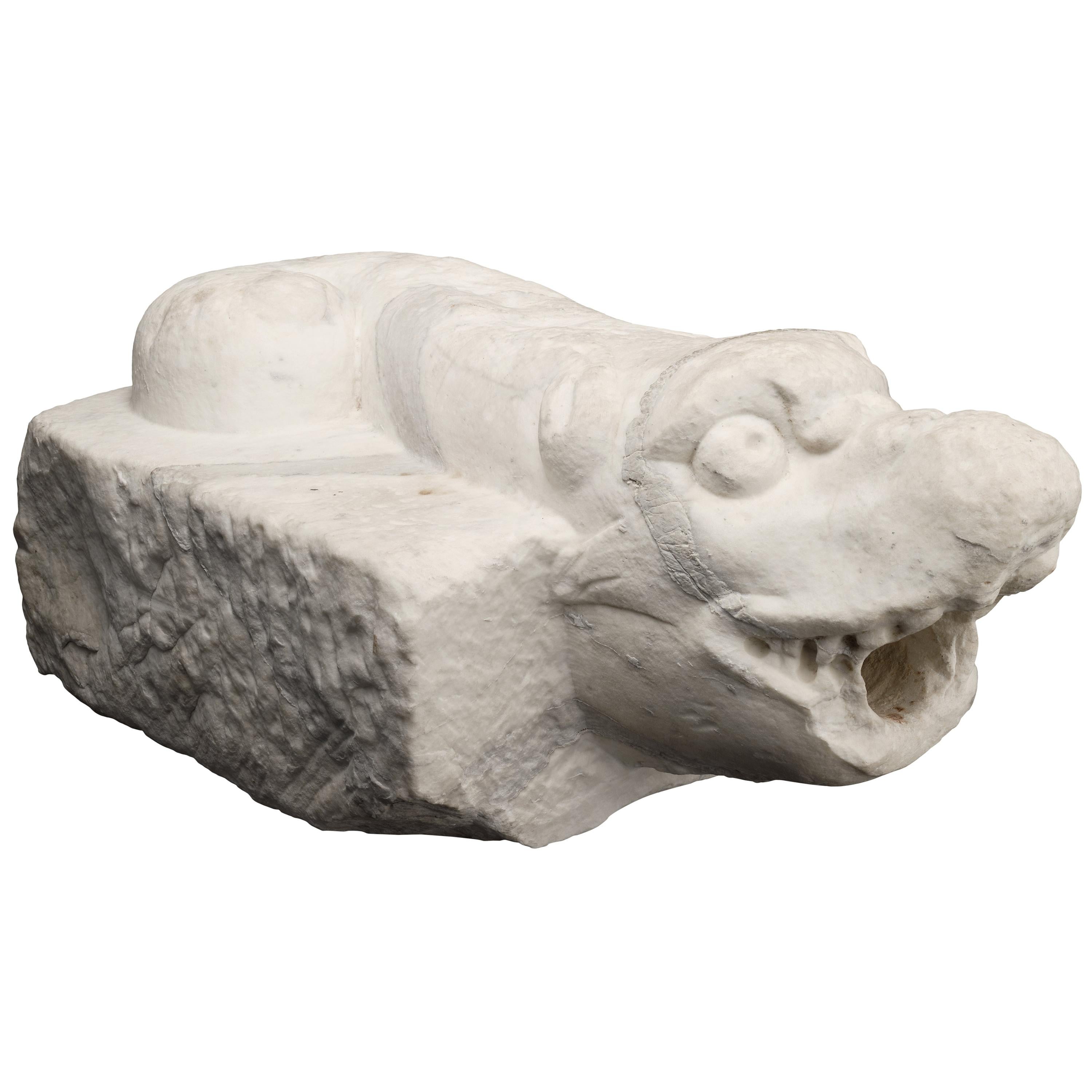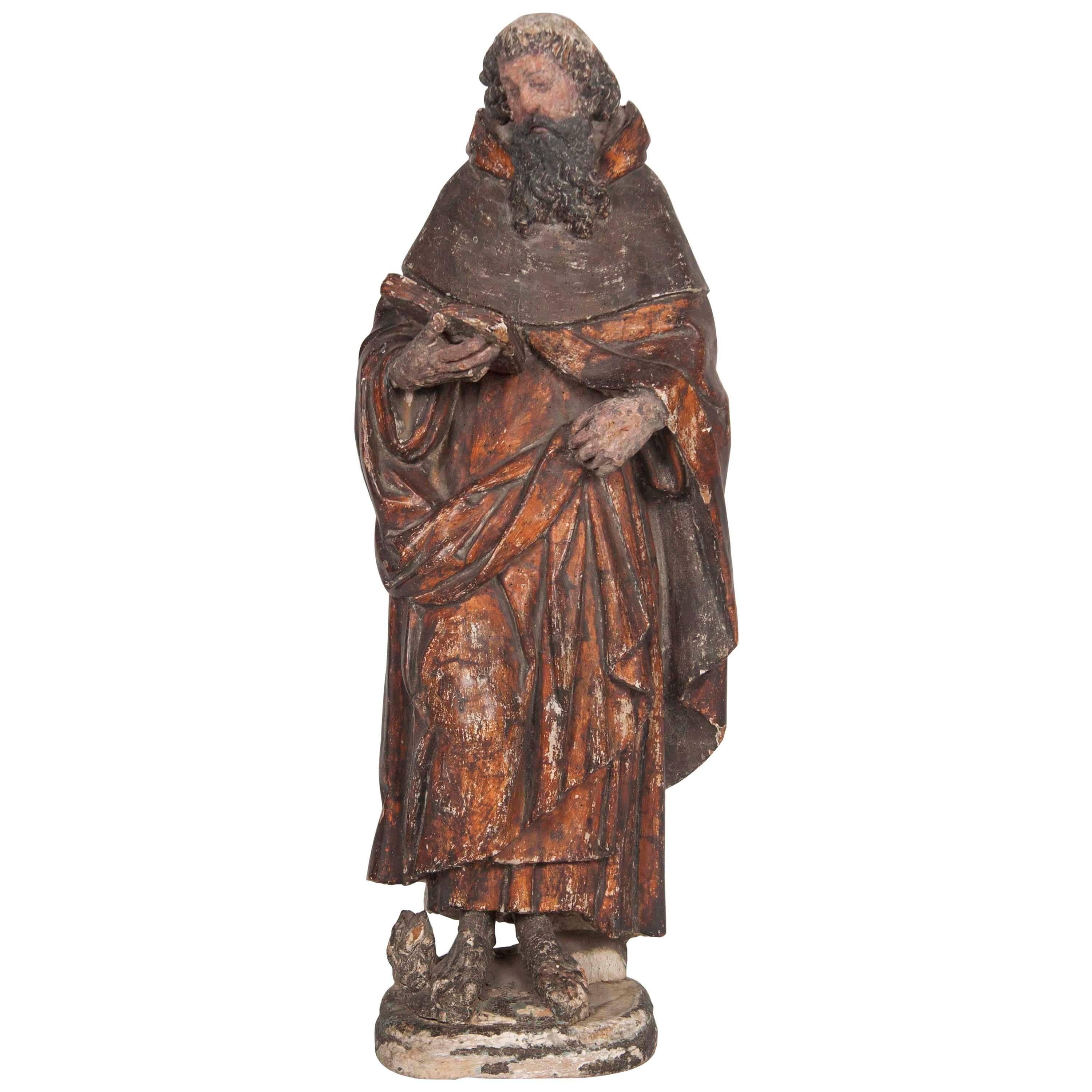Items Similar to Griffin Head, Italy, 16th Century
Want more images or videos?
Request additional images or videos from the seller
1 of 5
Griffin Head, Italy, 16th Century
About the Item
Griffin head
Italy, 16th century
On a modern metal stand
Measures: 20 x 29 x 21 cm (without the stand)
The griffin is a legendary creature with the body of a lion, the head and wings of an eagle and horse ears.
Because the lion was traditionally considered the king of the beasts, and the eagle the king of the birds, by the Middle Ages, the griffin was thought to be an especially powerful and majestic creature.
Since classical antiquity, griffins were known for guarding treasures and priceless possessions.
- Dimensions:Height: 7.88 in (20 cm)Width: 11.42 in (29 cm)Depth: 8.27 in (21 cm)
- Style:Renaissance (Of the Period)
- Materials and Techniques:
- Place of Origin:
- Period:
- Date of Manufacture:16th Century
- Condition:Wear consistent with age and use.
- Seller Location:Bruxelles, BE
- Reference Number:1stDibs: LU6666233657602
About the Seller
5.0
Vetted Seller
These experienced sellers undergo a comprehensive evaluation by our team of in-house experts.
1stDibs seller since 2022
6 sales on 1stDibs
Typical response time: 7 hours
- ShippingRetrieving quote...Ships From: Bruxelles, Belgium
- Return PolicyA return for this item may be initiated within 3 days of delivery.
More From This SellerView All
- Group of Altarpiece - Antwerpen, 16th centuryLocated in Bruxelles, BEGroup of altarpiece representing the life of a Saint, Saint Renualde? Engraved by the sign of Antwerp hand on the hat of the central character Carved oak, traces of polychromy Fir...Category
Antique 16th Century Belgian Renaissance Figurative Sculptures
MaterialsOak
- Massacre of the Innocents, Normandy, Late 16th CenturyLocated in Bruxelles, BEThe Massacre of the Innocents Carved oak panel Normandy, late 16th century (Collection labels on the back) Measures: 43,5 x 61 cm.Category
Antique 16th Century French Renaissance Wall-mounted Sculptures
MaterialsOak
- renaissance wooden candelabrum and painted cross - Umbria, 16th centuryLocated in Bruxelles, BEBase of a carved wooden candelabrum, polychrome and gilded; cross painted on both sides. Umbria or Tuscany, 16th century 136 x 43,5 x 30 cm (The cross and the base of the candelabrum were later assembled) The base of the candelabrum is intricately carved and adorned with polychrome and gilded finishes. The shafts take on the shape of balusters reminiscent of ancient columns, feature ornate foliage decorations, garlands and winged cherub faces. The feet are crafted in the likeness of lion paws. The base is further embellished with depictions of four saint martyrs, among them Saint Barbara and Saint Catherine of Alexandria. The plasticity of the figures, outlined with strong contour lines, the clear and vibrant colors, are stylistic elements linked to the Umbrian tradition of the sixteenth century.The precisely defined and elegant drawing, along with the clear color palette applied with refined chiaroscuro modulations, became the signature of a style that would leave a lasting mark on the era to come. This is exemplified by a preference for vibrant, multicolored images, accentuated in this case by the use of red and pink in the saint's attire. A notable addition, introduced later, is a polylobed cross painted on both sides. On one side, the Crucifixion is vividly portrayed:The treatment of the corpus itself is in line with High Medieval practice, emphasizing pathos by showing Jesus dead, his arms sagging from the weight of the body. The upper section displaying a pelican pecks at her breast to feed her young with her own blood; a symbol of the sacrifice of Christ on the cross whose body and blood similarly nourishes the celebrant during Mass. The lower part depicts Golgotha. On the reverse side, the Resurrection is artistically presented in a Renaissance iconography, reminiscent of the renowned composition painted by Piero della Francesca, now housed in the Civic Museum of Sansepolcro. In terms of composition, with the frontal depiction of Christ holding the banner, this motif became particularly widespread in central Italy, spanning from Tuscany to Umbria throughout the 16th century.. The double-sided construction suggests that it may also have been carried in liturgical processions. In Umbria from the 14th century, the use of portable crosses painted on both sides had become a widespread practice, aimed at satisfying the monastic clientele that had significantly increased following the establishment of new religious communities. The earliest surviving Tuscan painted crucifix represent Christ as Christus Triumphans, or the “Triumphant Christ” with his head up and eyes open. This form was supplanted in the 13th century with the Christus Patiens, or “Suffering Christ” type who is shown often with his head fallen on his shoulder and his eyes closed, as In our cross. The iconography of the suffering Christ appears to have developed out of a new interest in Christ’s human nature, the development of the feast of Corpus Christi and with increased importance given to the Eucharist. The process of humanizing the figure of Christ reaches its peak with the abandonment of all the previous expressive conventions in favor of more realistic details we can observe in this Crucifix, such as the swollen belly, the arms stretched to the limit of muscle tearing, the body falling heavily forward, the abundant blood on the wounds, and the cross firmly embedded in the rock of Calvary. It's worth noting that Renaissance candelabra...Category
Antique 16th Century Italian Renaissance Figurative Sculptures
MaterialsWood, Giltwood
- Florentine Leather Casket, 16th CenturyLocated in Bruxelles, BEFlorentine leather casket Italy, Tuscany 16th century leather, iron and wood. Very rare boiled leather box incised on a wooden core; iron lock. The central shield is divide...Category
Antique 16th Century Italian Renaissance Decorative Boxes
MaterialsIron
- Cerberus, Italy, 17th CenturyLocated in Bruxelles, BECerberus Black painted stone Italy, 17th century Measures: 80 x 69 x 36cm (one head missing) Cerberus, cruel monster, fierce and strange, Through his wide threefold throat barks as a dog Over the multitude immers'd beneath. His eyes glare crimson, black his unctuous beard, His belly large, and claw'd the hands, with which He tears the spirits, flays them, and their limbs Piecemeal disparts (Dante, Inferno, Canto VI). Cerberus figure seated, in his role of ferocious guardian of the underworld; he shows a nervous musculature, an adherent skin which reveals the ribs, long and robust limbs; his heads are broad and the eyes set well apart. Painted in black to amplify his menacing look, the infernal guardian is depicted with his famous attributes, writhing his heads, growling and barking furiously. Cerberus, in Greek mythology, was the monstrous watchdog of the underworld – also known as the “hound of Hades” – preventing the dead from leaving, and making sure that those who entered never left. A child of Typhon and Echidna, he was part of a monstrous family, which included Orthus, the Lernaean Hydra, and the Chimaera as well. Only on three occasions Cerberus was tricked by visitors of Hades: Heracles did it with his strength, Orpheus with his music. In "The Inferno", Dante places Cerberus as the guardian of the third circle of Hell. With his three mouths, Dante saw Cerberus as a beast that was synonymous with the sin of Gluttony. Virgil gets past the monster by throwing mud in his three mouths, temporarily choking him. Very rare are the representations of Cerberus in ancient statuary...Category
Antique 17th Century Italian Renaissance Figurative Sculptures
MaterialsStone
- Bronze Mortar, Tuscany, Second Half of 16th CenturyLocated in Bruxelles, BEBronze mortar with garlands, flowers and putti - Tuscany , second half of 17th century. Measures: height 10 diameter : 13 cm Artisans and healers used mortars for grinding food...Category
Antique 16th Century Italian Renaissance Scientific Instruments
MaterialsBronze
You May Also Like
- Male Head, Carved Stone, Spain, 16th CenturyLocated in Madrid, ESMale head. Carved stone. Century XVI. Carved stone relief showing a male face turned to the right. It is necessary to highlight both the quality of the fac...Category
Antique 16th Century Spanish Renaissance Decorative Art
MaterialsStone
- 16th Century Head Of A NobleLocated in Atlanta, GAA very striking 16th century statue - head of a nobleman - crafted from Roman concrete - opus caementicium. Roman concrete is durable due to its incorporation of volcanic ash, which...Category
Antique 16th Century Italian Figurative Sculptures
MaterialsCoade Stone
- Winged angel head. Polychrome wood. Spanish school, 16th century.Located in Madrid, ESWinged angel head. Polychrome wood. Spanish school, 16th century. Carved and gilded wooden sculpture that shows a child's head with blonde, curly hair adorned with two wings. This ty...Category
Antique 16th Century European Renaissance Figurative Sculptures
MaterialsOther
- Italian Ancient Marble Sculpture Fountain, Late 16th CenturyLocated in Milano, ITSea monster Carrara marble mouth fountain Italy, late 16th century It measures 13.8 x 31.5 x 18.9 in (35 x 80 x 48 cm) State of conservation: some small evident gaps and widespread signs of wear due to outdoor exposure. The gray marks crossing it do not come from restoration, but are rather the natural veins of the marble. This work has some morphological characteristics typically associated with the iconography of the sea monster: an elongated muzzle, sharp teeth, protruding eyes, elongated ears, and a coiled serpent's tail. An in-depth series of studies on artistic depictions of the sea monster attempted to verify how this symbol evolved in antiquity in the European and Mediterranean contexts and how it gradually changed its image and function over time. The iconography itself is mutable and imaginative and its history is rich with cultural and artistic exchange, as well as the overlapping of ideas. This occurred so much that it is difficult to accurately pinpoint the "types" that satisfactorily represent its various developments. However, we can try to summarize the main figures, starting from the biblical Leviathan and the marine creature that swallowed Jonah (in the Christian version, this figure was to become a whale or a "big fish", the “ketos mega”, translation of the Hebrew “dag gadol”). Other specimens ranged from the dragons mentioned in the Iliad (which were winged and had legs) to "ketos” (also from Greek mythology), the terrifying being from whose Latinized name (“cetus”) derives the word "cetacean". See J. Boardman, “Very Like a Whale” - Classical Sea Monsters, in Monsters and Demons in the Ancient and Medieval Worlds, in Papers presented in Honor of Edith Porada, Mainz am Rhein 1987, pp. 73-84). In Italy the monster underwent yet further variations: it can be found in Etruscan art on the front of some sarcophagi representing the companion of souls, while among the Romans we find the “Pistrice” (cited by Plinio in Naturalis Historia PLIN., Nat., II 9, 8 and by Virgilio in Eneide: VERG., Aen., III, 427), which appeared in the shape of a stylized hippocampus or a very large monstrous cetacean and evolved into a hideous being with a dragon's head and long webbed fins. During the Middle Ages, the sea monster was the object of new transformations: at this time, it is often winged, the head is stretched like a crocodile, the front legs are often very sharp fins - sometimes real paws - until the image merges with dragons, the typical figures of medieval visionary spirituality widely found throughout Europe (on this topic and much more, see: Baltrušaitis, J., Il Medioevo fantastico. Antichità ed esotismi nell’arte gotica, Gli Adelphi 1997). In Italy during the 15th and 16th centuries, the revival of classicism - representative of the humanistic and Renaissance periods - led to a different reading of these "creatures". Indeed, the sea monster was also to find widespread use as an isolated decorative motif, especially in numerous fountains and sculptures where dolphins or sea monsters were used as a characterizing element linked to water (on this theme see: Chet Van Duzer, Sea Monsters on Medieval and Renaissance Maps, London, The British library, 2013). From the morphological point of view, the "sea monsters" of this period are mostly depicted as hybrid figures, in which the body of a mythological or real being (a hippocampus, a sea snake, a dolphin), is joined to a head with a rather indistinct appearance. It was usually characterized by large upright ears, an elongated snout, sharp teeth and globular, protruding eyes; a complex and indefinite figure, both from the symbolic point of view and from that of its genesis. The work we are examining is placed as a cross between the medieval sea serpent and the Renaissance dolphin, with stylistic features which recall the snake as often used in heraldry (such as the "snake" depicted in the coat of arms of the Visconti - the lords and then dukes of Milan between 1277 and 1447 - and which, for some, may be derived from the representations of the “Pistrice” that swallowed Jonah). In the search for sources, Renaissance cartography and in particular woodcuts should not be neglected. See for example the monsters of Olaus Magnus, from the editions of the “Historia de gentibus septentrionalibus” (“History of the peoples of the north”) and the natural histories of Conrad Gesner, Ulisse...Category
Antique 16th Century Italian Renaissance Animal Sculptures
MaterialsCarrara Marble
- Misericord. Carved wood. 16th century.Located in Madrid, ESChoir Mercy. Carved wood. Century XVI. Carved wooden Misericordia that surely belonged to a choir stall (see the upper flat part, which acts as a seat), decorated with a figurative ...Category
Antique 16th Century European Renaissance Figurative Sculptures
MaterialsOther
- 16th Century Italian Renaissance Carving of a Male SaintLocated in Stamford, CT16th century Italian carved and polychromed figure of a male saint or prophet with a wonderful presence. Shown holding an open book in his right hand with flames at his feet, mid-16t...Category
Antique 16th Century Italian Renaissance Religious Items
MaterialsWood
Recently Viewed
View AllMore Ways To Browse
Metal Head
Antique Earings
Antique Ear
Italy 16th Century
King Head
16th Century Italy Furniture
16th Century Italian Furniture
16th Renaissance
16th Century Renaissance
Antique Griffin
Griffin Antique
Antique Griffin Furniture
Marble 16th
Marble Lion Head
Carved Griffins
Carved Renaissance 16th
Carved Beasts
Lions Head On Stand





